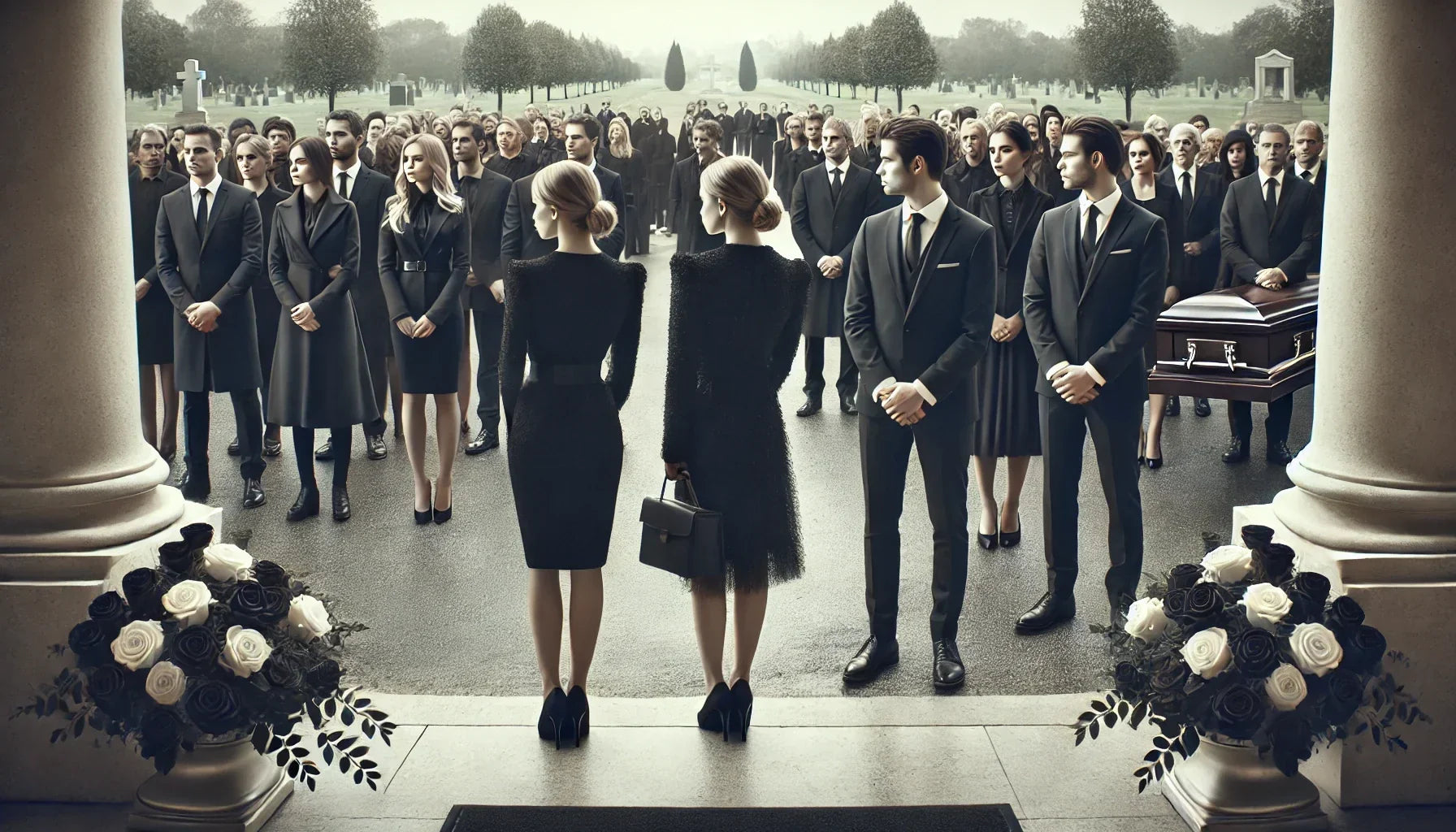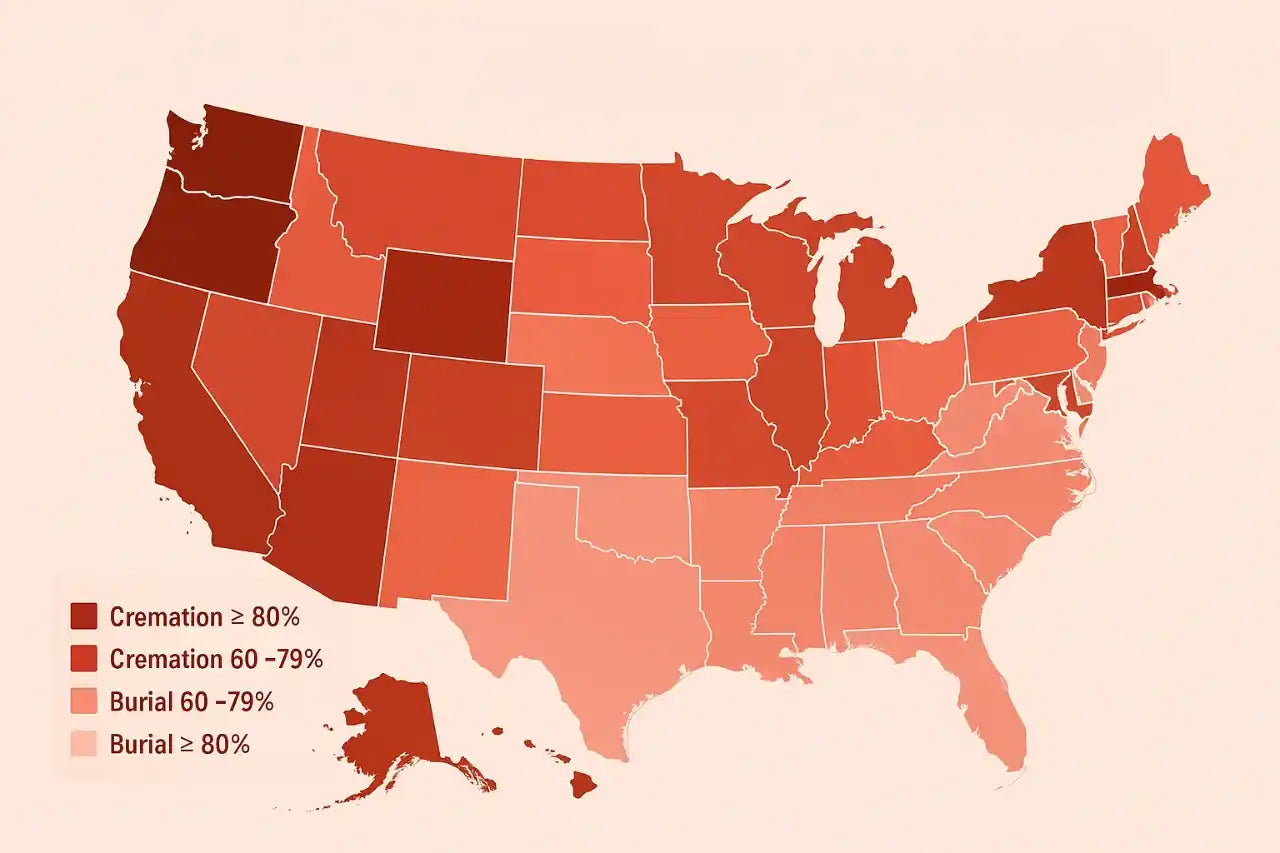Dressing for a funeral isn’t about fashion, it’s about respect. In a moment of grief, what you wear sends a silent message of support, empathy, and acknowledgment of the loss. Black is the traditional go-to in many Western cultures, but different religions and traditions have their expectations, from white mourning attire in some Asian cultures to subdued yet colorful clothing in parts of Africa.
The key? Show up in a way that honors the deceased and their family. The right outfit is about fitting in, showing consideration, and letting your presence be a quiet comfort rather than a distraction. But in 2025, as styles evolve and traditions mix, what does “appropriate” really mean? Let’s break it down.

General Guidelines for Funeral Attire
As we know, black remains the safest and most traditional color, but depending on the cultural context, other dark, subdued tones such as navy, charcoal, or deep brown can also work well. So, avoid bright colors, flashy patterns, or anything that draws unnecessary attention. Even if the deceased was someone known for their love of vibrant fashion, the goal is to honor them without making yourself the focal point.
Muted clothing doesn’t mean looking dull, it means dressing with subtlety. A well-tailored black or dark-colored suit, a modest dress, or a blouse with a knee-length skirt creates an understated elegance that fits the occasion. Accessories should follow the same principle: simple jewelry, classic shoes, and a neutral handbag. If you have to question whether something is “too much,” it probably is.

How to Balance Formality and Comfort
Formal attire is the standard, but comfort still matters, especially if the funeral involves extended ceremonies, standing for long periods, or outdoor elements like graveside services.
For men, a properly fitted suit with a white or muted dress shirt and polished shoes works well. If a full suit feels excessive for the setting, a blazer with dark trousers and a plain tie is an alternative.
For women, a well-fitted dress, blouse with slacks, or a conservative skirt suit is appropriate. Fabrics matter more than most realize; breathable wool or cotton blends are ideal for warmer climates, while heavier materials work better in cold weather. Footwear should be comfortable yet polished, funerals often involve walking, sometimes on uneven ground, so stiletto heels may not be the best choice.
The Hidden Influences on Funeral Attire
Many people assume funeral attire is universal, but that couldn’t be further from the truth. What’s acceptable in one setting might be completely inappropriate in another.

Weather Considerations: A summer funeral means light but respectful fabrics; linen suits or conservative dresses with a shawl. In winter, layering is key, but even outerwear should remain understated; a black wool coat works, while a neon-colored puffer jacket doesn’t.
Location Matters: A funeral held in a church or funeral home calls for traditional formality, whereas a beachside or backyard memorial service may allow for slightly more relaxed attire (but still no flip-flops or ripped jeans).
Cultural and Religious Traditions: Many cultures have distinct funeral dress codes. In some Asian cultures, white, not black, is the traditional color of mourning. In Hindu ceremonies, attendees often wear simple white clothing. Jewish funerals may require men to wear a kippah, while Muslim funerals often encourage modest, loose-fitting clothing with head coverings for women.
Your Relationship to the Deceased: Immediate family members usually dress in the most formal attire, while distant relatives or acquaintances might choose slightly more relaxed versions of the same dress code. However, erring on the side of overdressing is always safer than being too casual.
Traditional Funeral Attire (Western Standards)
In Western culture, traditional funeral attire follows a solemn, understated style that represents the gravity of the occasion. Dark colors, conservative cuts, and minimal accessories are the norm. The goal? To honor the deceased without drawing unnecessary attention to yourself.

Men’s Funeral Attire
A well-fitted black, navy or dark gray suit is the gold standard. If a suit feels too formal for the setting, a dark blazer with dress pants works too. A crisp white or neutral-colored dress shirt keeps the look polished, while the tie should remain subtle; nothing too bright, flashy, or patterned.
Shoes matter more than most realize. A polished pair of black or dark brown dress shoes completes the outfit, but avoid sneakers, sandals, or anything too casual. If the weather is cold, an overcoat in a dark shade is appropriate, and accessories like scarves and gloves should follow the same muted tone.
What to avoid? Casual jeans, T-shirts, anything neon or overly stylish, and distracting accessories. It’s not about you; it’s about paying your respects.

Women’s Funeral Attire
For women, the key is modesty and simplicity. A black or dark-colored dress is the most common choice, but a skirt or pantsuit in the same somber tones works just as well. Anything too short, revealing, or heavily patterned should be avoided; funerals aren’t the place for trendy cutouts or loud floral prints.

A conservative blouse pairs well with dark skirts or slacks. Sheer materials, plunging necklines, or overly tight fits can feel out of place. When it comes to shoes, closed-toe options like flats or low heels are best. Stilettos? Probably not the right setting.
Jewelry and accessories should be kept to a minimum. If you normally wear statement pieces, dial it down. A simple watch, stud earrings, or a delicate necklace is more than enough. If it’s chilly, a dark blazer, shawl, or cardigan is a practical addition.
Makeup and hairstyles should follow the same understated approach. A natural look is best; overly bold lipstick or dramatic eye makeup can feel inappropriate in such a somber atmosphere.
Children’s Funeral Attire
Children aren’t usually expected to follow strict dress codes, but their clothing should still be respectful. A young boy in dress pants and a button-up shirt is perfectly suitable. A tie is optional, depending on the formality of the event.
For girls, a simple dark dress or a skirt with a modest blouse works well. Bright colors, playful patterns, and cartoon character prints should be avoided. Of course, kids may not fully understand the meaning of a funeral, but their clothing should still suit the occasion.

Parents should also consider comfort. Young children get restless, so fabrics that feel stiff or overly formal may lead to unnecessary fussing. Choose well-fitted but comfortable attire that allows them to sit quietly through the service.
Funeral Attire Based on Cultural and Religious Traditions
Every culture and religion has its way of mourning, and wearing the right attire is a silent yet powerful way of showing support and reverence. Let’s go beyond the basics and truly understand what funeral attire means across different traditions.

Christian Funerals (Catholic, Protestant, etc.)
Black. Conservative. Formal. These are the non-negotiables for most Christian funerals, particularly in Western traditions. Whether it’s a Catholic mass or a Protestant service, dark, muted colors signify mourning and respect. Men typically wear suits or dress shirts with slacks, while women choose dresses, skirts, or formal pantsuits.

However, subtle distinctions are depending on denomination and culture. In some Catholic communities, particularly in Latin America and Southern Europe, mourning attire may extend beyond the funeral; widows and immediate family members may wear black for months, even years. Protestant services, on the other hand, may allow for more flexibility, particularly among modern, non-denominational churches. Some services encourage attendees to wear colors that reflect the deceased’s personality, especially in "celebration of life" services, which are becoming more common.
Unique Insight: In some Orthodox Christian funerals, women are expected to wear head coverings inside the church. If attending, it’s best to carry a scarf, just in case.
Jewish Funerals
Jewish funeral attire is about humility. Dark, conservative clothing is expected, but black isn't always mandatory. Modesty is key; nothing flashy, no loud patterns. Men often wear a kippah (yarmulke) out of respect, even if they aren’t Jewish. Women may be expected to cover their shoulders and wear a long skirt rather than pants.
A unique aspect of Jewish funerals is the torn garment or ribbon, known as "keriah," worn by immediate family members. It symbolizes grief and the tearing apart of one’s heart in mourning.

Unique Insight: Avoid leather shoes. In some Jewish traditions, wearing leather at a funeral is discouraged as a sign of humility and detachment from material luxury. If in doubt, opt for fabric or synthetic footwear.
Muslim Funerals
In Islam, funeral attire is dictated by strict principles of modesty. Women should wear long, loose-fitting dresses or skirts with a headscarf, ensuring their arms and legs are covered. Men should wear long trousers and a long-sleeved shirt, typically in dark or neutral colors.
Unlike Western traditions, black isn’t necessarily required, any simple, subdued color is generally acceptable. However, extravagant clothing and excessive jewelry are discouraged. The goal is humility, as Islamic funerals focus on the afterlife rather than worldly displays.

Unique Insight: In some cultures, female attendees may be expected to cover their hair even if they aren’t Muslim. It’s always a good idea to carry a lightweight scarf in case it’s needed.
Hindu Funerals
Forget black; white is the mourning color in Hindu tradition. This stems from the belief that white represents purity and detachment from the material world. Attendees are expected to wear simple, modest clothing, with minimal accessories. Women usually wear plain saris or long skirts, while men opt for traditional white garments or simple, light-colored shirts and pants.
Unlike many Western traditions, Hindu funerals are often more ritualistic and involve open-air cremations. This means attendees should wear comfortable, breathable clothing, especially if the ceremony takes place outdoors.

Unique Insight: In many Hindu communities, leather accessories (shoes, belts, bags) are discouraged at funerals as they are seen as impure. So, select fabric-based alternatives when attending.
Buddhist Funerals
Buddhist funeral attire varies based on the sect and cultural background, but the general rule is simplicity. White is often worn by the family as a sign of mourning, while guests may wear subdued colors like gray, beige, or light brown. Black isn’t always appropriate, as it can be associated with Western mourning traditions rather than Buddhist customs.
Unlike in some faiths where mourning is about sorrow, Buddhist funerals focus on honoring the deceased’s journey to enlightenment. Guests should dress in a way that demonstrates serenity and reverence, avoiding bold patterns, flashy jewelry, or excessive makeup.

Unique Insight: In some Buddhist traditions, guests may be asked to bow in front of the deceased or the altar. Wearing clothing that allows for comfortable movement (like long skirts or loose-fitting trousers) is a practical choice.
Other Cultural Variations
In some African and Afro-Caribbean cultures, funerals are deeply spiritual and communal events. Some communities stick to traditional black attire, others hold bright colors and patterned fabrics to celebrate the life of the deceased rather than mourn their passing. Ghanaian funerals, for example, often feature elaborate red and black clothing, while Jamaican funerals might allow for white or even vibrant colors depending on the family’s wishes.
Unique Insight: In some African traditions, attendees may wear custom funeral cloth; a specially made fabric with symbols or prints representing the deceased's life.
What to Avoid Wearing to a Funeral
Now, let’s get into the details of what not to wear, and why.
Red, neon shades or bold prints have no place at a funeral. These colors scream for attention when the moment calls for quiet reflection. Some cultures even see certain bright colors as inappropriate or offensive for mourning.
But this is where things start to get complicated; some families do request specific colors to honor their loved ones. If the family has mentioned a color theme (for example, wearing the deceased's favorite color), that’s different. In those cases, it’s okay to follow their wishes. Otherwise, stick to dark, muted tones like black, navy, or gray.

Let’s admit, funerals are serious events, and showing up in shorts, tank tops, ripped jeans, or anything you’d wear to lounge around on a Saturday doesn’t cut it. Even if the service is "casual," that doesn’t mean disrespectfully casual.
Think of it like this: If you wouldn’t wear it to a job interview or a professional event, don’t wear it to a funeral. A simple, well-fitted outfit that looks neat and put together is always the right call.
Loud Accessories, Excessive Makeup, and Heavy Perfume
You don’t want to be the person who jingles with every step because of noisy jewelry. You also don’t want to be remembered as the one who left an overpowering scent lingering in the air.
-
Stick to subtle jewelry. A small necklace, a watch, or simple earrings are fine; just avoid anything oversized or flashy.
-
Makeup should be natural. A funeral isn’t the place for bold lipstick, dramatic eyeshadow, or glitter. Keep it understated.
-
Perfume should be barely noticeable if worn at all. Some people attending may be sensitive to strong scents, and funerals are already emotional enough without triggering headaches or allergies.
Inappropriate Footwear
Flip-flops? Absolutely not. Sneakers? Not unless they are extremely understated and clean. Bright-colored running shoes? Definitely not.
Funerals often involve standing for long periods and sometimes walking on grass or uneven ground at the burial site. The last thing you want is to be clomping around in loud, inappropriate shoes or, worse, struggling to walk in uncomfortable stilettos.
The best choices? Simple, polished dress shoes, loafers, ballet flats, or modest heels. Something you can walk in comfortably, without drawing unnecessary attention.
Conclusion: Dressing with Respect
Funerals are about showing up; not just physically, but emotionally. The way you dress is a sign of respect, both for the person who has passed and for the grieving family. In 2025, funeral attire still leans toward tradition, but personal touches and cultural considerations matter more than ever. A well-chosen outfit isn’t about looking stylish; it’s about fitting in, honoring the occasion, and avoiding anything that could distract from the moment.
That means dark, subdued colors, clean lines, and a fit that makes you feel presentable but comfortable. If the family has requested something specific; lighter colors, cultural attire, or even a theme; respect that. When in doubt, err on the side of formality. Don’t try to impress anyone. You’re there to support, remember, and pay tribute. And if your clothing demonstrates that, you’ve done it right.


